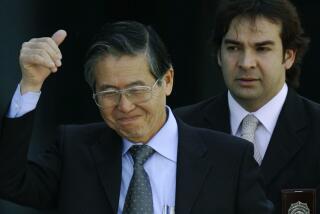Peru Under Pressure to Bring Former Spymaster to Justice
LIMA, Peru â Vladimiro Montesinos is hiding on a military base here protected by renegade officers.
Or heâs holed up on a ranch in Bolivia. Or heâs in Moscow hanging out with the Russian mob. Or heâs dead.
In descending order of probability, those are some of the theories circulating among well-informed Peruvians. Mystery and myth envelop Montesinos, the fugitive former spy chief whose defiant return from exile a month ago brought about the downfall this week of President Alberto Fujimori.
âPeople call to say Iâve seen him here, Iâve seen him there,â said Jose Carlos Ugaz, the special prosecutor overseeing half a dozen investigations of Montesinos. âFantasy plays a big role. One night somebody called to say they had just seen him . . . in a sport-utility vehicle with tinted windows at 9 at night.â
As Peru enters a hopeful new chapter, the caretaker government inherits two urgent missions. It must capture Montesinos, something that Fujimori would not or could not do before he resigned Monday. And authorities must build a criminal case against the former advisor who was known as the former presidentâs Rasputin.
Ugaz has been inundated with leads and raw evidence in recent days. With each dizzying revelation, he said, Montesinos looks more and more like a gangster who converted the Peruvian government into a multimillion-dollar mafia comparable to criminal empires in Mexico, Colombia and other nations.
âThis concerns not just an individual but a criminal apparatus that took control of the armed forces, the police, the justice system,â Ugaz said in an interview Wednesday. âWhatâs impressive is the breadth of all this. It was not a criminal organization outside the power structure; it was installed in the power structure itself.â
The investigation and the manhunt mean a lot to the future of Peru. Although the spymasterâs once-mighty web is in tatters, only his capture will ensure that he no longer poses a threat to democracy.
Moreover, many Peruvians say the Fujimori regime became a textbook example of impunity, an ailment that cripples Latin American democracies. They want to set an example by punishing the guilty. But the new government also wants the rule of law to prevail over blind political revenge.
The task is delicate because the probes have already raised serious allegations against Fujimori, whose self-imposed exile in Japan brought widespread anger here. The prosecutor has asked authorities in Singapore to look into an allegation that Fujimori recently removed $18 million from bank accounts there and transferred it to Japan. Fujimori, whose ex-wife also claims he has secret accounts in Malaysia, denies holding any accounts outside Peru.
Alleged Ties to Late Drug Lord Are Probed
In addition, Ugaz opened a probe into accusations that the late Colombian drug lord Pablo Escobar contributed $1 million to Fujimoriâs presidential campaign 10 years ago. The drug lordâs brother, Roberto Escobar, alleged recently in an interview with Cambio, a Colombian magazine, that Montesinos was an intermediary involved in supplying coca paste, the raw material for cocaine, to Escobarâs cartel and that Montesinos funneled the contribution to the campaign.
âWe will investigate any evidence that connects Fujimori to Montesinos, though I do not have a mandate to investigate Fujimori,â said Ugaz, 41, one of Peruâs most respected lawyers.
Ironically, Fujimori appointed Ugaz three weeks ago in an apparent effort to restore credibility.
Ugaz, who has the quiet, intent air of a boxer in repose, served as an occasional special prosecutor on major cases for the Fujimori government. But he also defended journalists and other dissidents against the regime. He said Fujimori tried to fire him six days after making him special prosecutor this month.
âHe said I had become uncomfortable for him,â Ugaz said. The president relented when his justice minister backed Ugaz and threatened to resign, Ugaz said.
Some of the current cases reinforce longtime accusations of human rights abuses and systematic corruption, casting further doubt on the U.S. governmentâs portrayal of Montesinos and Fujimori as staunch allies in the drug war.
âFor me, this was evident years ago,â Ugaz said. âIt was not a frank and efficient fight against drug trafficking or other types of crime. They played at pure symbolism.â
As a high-powered lawyer in the 1980s, Montesinos represented Colombian and Peruvian drug lords. The recently launched investigation indicates that when Montesinos became spy chief in 1990, he played a classic double-game: He allegedly fought some traffickers and protected others. New witnesses allege that the spy chiefâs military accomplices ambushed drug shipments in the jungle, killed the traffickers and sold the drugs themselves, according to Ugaz.
And Ugaz wants to question a potential key witness: Sarkis Soghanalian, a arms dealer in Los Angeles who told The Times last month that Montesinos organized the purchase of 10,000 AK-47 rifles that were airdropped to Colombian guerrillas. Peruâs massive and sometimes dubious purchases of Russian-made aircraft and other military goods could prove a prime source of illicit fortunes attributed to Montesinos and other high-ranking officials.
Authorities have detected at least $58 million in bank accounts in Europe, Latin America and the Cayman Islands, but Ugaz believes the spy chief accumulated hundreds of millions of dollars. He said the U.S. Embassy has promised to help pursue leads, such as investigating a Montesinos bank account in New York.
Peruvian leaders also want the U.S. to lend its high-tech investigative might to the hunt for Montesinos, just as U.S. intelligence services helped the massive Colombian dragnet that ended in Pablo Escobarâs slaying in 1993. Peter Romero, assistant secretary of State for Western Hemisphere affairs, indicated this week that the U.S. would accept a formal request.
Prosecutor Discounts Fujimoriâs Raids
Although Ugaz is not in charge of the search for Montesinos, he knows enough about it to have strong opinions.
âMy impression is that no one is looking for him right now,â he said. He expressed doubt about the swashbuckling images of Fujimori leading a squad of commandos recently who ransacked apartments, beach homes and a weekend cottage linked to Montesinos. In reality, Fujimori seemed mainly concerned about finding the stash of compromising videos and documents that Montesinos compiled against powerful Peruvians, Ugaz and others said.
âThey were looking for something, whether it was Montesinos or what Montesinos had,â he said. âThe way in which the operations were conducted was not very rigorous.â
And the question persists: Where is Montesinos?
The strongest theory places him in Peru and under the protection of an armed forces command that still owes him allegiance, according to Ugaz and others. That would help explain the lack of progress.
âItâs difficult to raid the house of a general, to search the closets in a generalâs house,â said Raul Gonzalez, a Peruvian sociologist and expert on the security forces.
The lack of hard information about the spy chiefâs clandestine odyssey shows how facts, as well as institutions, fall victim to authoritarianism.
Montesinos has not been seen in public since his private plane stopped in Ecuador on return from exile in Panama to Peru. He has not been heard from since he gave a brief radio interview from hiding Oct. 24, the day after his return. According to a well-informed government official, Montesinos ordered the hurried departure from Peru on Oct. 27 of a legislator under investigation in the bribery scandal that had brought down the spy chief in September.
Fujimori told reporters that he last spoke by telephone with Montesinos on Oct. 30 and demanded that he turn himself in.
Searchers believe the fugitive is accompanied by two bodyguards and a medic, whom Montesinos needs because he has a heart problem. They also have identified a telecommunications expert believed to be thwarting attempts to intercept Montesinosâ phone calls.
The last indirect sign of activity from Montesinos came three weeks ago. His archrival, Fernando Olivera, the legislator who obtained the videotape that uncorked the bribery scandal, announced that Montesinos had sent him a message via an admiral. Montesinos said he feared that Fujimori intended to kill him and offered to surrender on the condition that the former spy chief would be guaranteed safety and held under house arrest, according to Olivera.
Fujimoriâs aides downplayed that report, saying that Montesinos was manipulating the lawmaker.
Because both Fujimori and Montesinos are experts at psychological warfare, the case is clouded with doubt and suspicion. Politicians and commentators speculate that Montesinos is dead, presumably executed by his hunters, or that he has based himself on an estate in the Bolivian city of Santa Cruz, near that nationâs coca-growing heartland.
Several of Montesinosâ relatives, according to the well-informed government official, say he never really returned to Peru and instead took refuge with allies in the Russian mafia in Moscow.
A successful search will require political will and meticulous detective work. The challenge recalls the hunt for Abimael Guzman, the Peruvian guerrilla leader who seemed invincible until dogged anti-terrorist police tracked him to an apartment above a dance studio here in 1992.
Montesinos was Guzmanâs enemy. But he has acquired the same sinister, all-powerful image, like a real-life comic-book villain who obsesses and fascinates Peruvians.
There may be no quick results. Peru is still recovering from the Fujimori debacle. Interim President Valentin Paniagua is assembling his government. But the priority is to conduct a serious investigation, according to the special prosecutor.
âMontesinos will fall eventually,â Ugaz said. âItâs important to build a strong case. To have evidence that shows these crimes were committed, that the organization functioned this way. Thatâs whatâs most important at this moment.â
More to Read
Sign up for Essential California
The most important California stories and recommendations in your inbox every morning.
You may occasionally receive promotional content from the Los Angeles Times.










